#carthaginian mercenaries
Text
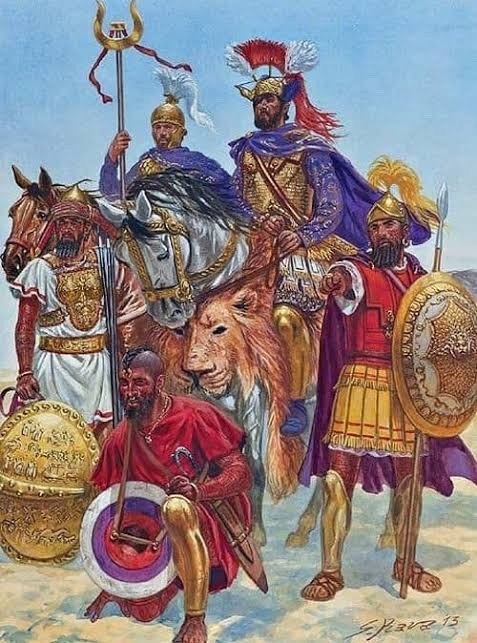




The First Act of the Mercenary Army in the Truceless War with Carthage.
“Throw!” For the Carthaginians being always accustomed to employ mercenary troops of miscellaneous nationalities, in securing that an army should consist of several different races, act wisely as far as the prevention of any rapid combinations for mutiny, or difficulty on the part of the commanders in overawing insubordination, are concerned: but the policy utterly breaks down when an outburst of anger, or popular delusion, or internal dissension, has actually occurred; for it makes it impossible for the commander to soothe excited feelings, to remove misapprehensions, or to show the ignorant their error. Armies in such a state are not usually content with mere human wickedness; they end by assuming the ferocity of wild beasts and the vindictiveness of insanity. This is just what happened in this case. There were in the army Iberians and Celts, men from Liguria and the Balearic Islands, and a considerable number of half-bred Greeks, mostly deserters and slaves; while the main body consisted of Libyans. Consequently it was impossible to collect and address them en masse, or to approach them with this view by any means whatever. There was no help for it: the general could not possibly know their several languages; and to make a speech four or five times on the same subject, by the mouths of several interpreters, was almost more impossible, if I may say so, than that. The only alternative was for him to address his entreaties and exhortations to the soldiers through their officers. And this Hanno continually endeavoured to do. But there was the same difficulty with them. Sometimes they failed to understand what he said: at others they received his words with expressions of approval to his face, and yet from error or malice reported them in a contrary sense to the common soldiers. The result was a general scene of uncertainty, mistrust, and misunderstanding. And to crown all, they took it into their heads that the Carthaginian government had a design in thus sending Hanno to them: that they purposely did not send the generals who were acquainted with the services they had rendered in Sicily, and who had been the authors of the promises made to them; but had sent the one man who had not been present at any of these transactions. Whether that were so or not, they finally broke off all negotiations with Hanno; conceived a violent mistrust of their several commanders; and in a furious outburst of anger with the Carthaginians started towards the city, and pitched their camp about a hundred and twenty stades from Carthage, at the town of Tunes, to the number of over twenty thousand. The men at once hurried to make a meeting; Spendius and Mathōs delivered violent invectives against Gesco and the Carthaginians; their words were received with every sign of approval; no one else could get a hearing; whoever did attempt to speak was promptly stoned to death, without the assembly so much as waiting to ascertain whether be intended to support the party of Spendius or no. A considerable number of privates as well as officers were killed in this manner in the various émeutes which took place; and from the constant repetition of this act of violence the whole army learnt the meaning of the word "throw," although there was not another word which was intelligible to them all in common. The most usual occasion for this to happen was when they collected in crowds flushed with wine after their midday meal. On such occasions, if only some one started the cry "throw," such volleys were poured in from every side, and with such rapidity, that it was impossible for any one to escape who once ventured to stand forward to address them. The result was that soon no one had the courage to offer them any counsel at all; and they accordingly appointed Mathōs and Spendius as their commanders.
#polybius of megalopolis#polybius histories#carthage#carthaginian mercenaries#truceless war#throw#languages#language barriers#humour#rome#roman#spqr
6 notes
·
View notes
Text

La bataille du Macar (The Battle of the Macar) by Georges Rochegrosse
#georges rochegrosse#art#carthage#mercenary war#battle of the macar#battle of the bagradas river#carthaginians#rebels#mercenaries#hamilcar barca#spendius#history#tunisia#mutinous#rebellious#soldiers#antiquity#mutiny#punic wars#elephants#elephant#war elephants#war elephant
154 notes
·
View notes
Photo
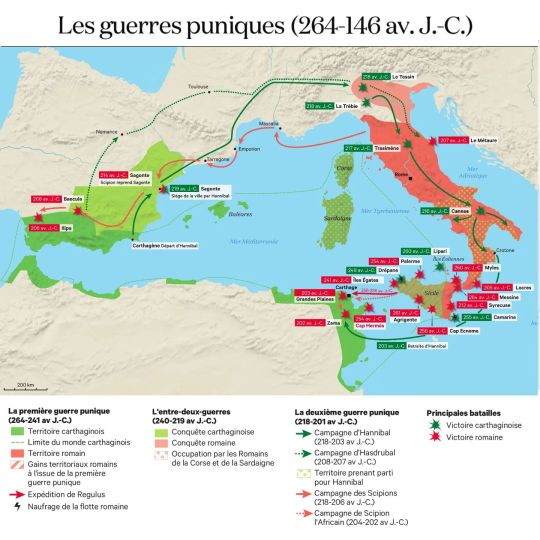
The Punic Wars, 264-146 BC
« Atlas historique mondial », Les Arènes, 2019
by cartesdhistoire
Rome and Carthage stood as the dominant powers in the western Mediterranean. Between these two influential states lay the island of Sicily. Situated at the crossroads of Europe and Africa, and bridging the eastern and western Mediterranean basins, Sicily held immense strategic importance. Rich in wheat and boasting a heritage of prosperity bestowed by both the Carthaginians in the west (in Palermo) and the Greeks in the east (in Syracuse), the island flourished. The Carthaginians established their capital at Lilybaea (modern-day Marsala) and maintained a major naval base at Drepane (modern-day Trapani).
In 264 BC, the onset of the First Punic War marked the first engagement of Roman legionnaires outside of Italy. While battles were fought in open fields, guerrilla warfare, and sieges, the defining feature of this conflict lay at sea. The pivotal Battle of the Aegate Islands in 241 BC resulted in the defeat of the Carthaginians, triggering another conflict, the far more perilous Mercenary War, on African soil. Fueled by grievances over unpaid wages, mercenaries and local allies revolted against Carthage, plunging the region into turmoil until order was restored by Hamilcar in 238 BC. A peace treaty with Rome was signed on March 10th.
The Second Punic War, commencing in 218 BC, was marked by an intriguing characteristic: personalization. The conflict became synonymous with the personalities of Scipio, later known as "the first African," and Hannibal, one of history's greatest military commanders. Hannibal's audacious invasion of Italy, driven by a desire to avenge Carthage's honor, catalyzed the war's escalation.
The war culminated in the Battle of Zama in 202 BC, leading to the signing of a final treaty in 201 BC. From this point forward, Rome emerged unchallenged in the Mediterranean. However, it wasn't until 197 BC that the Senate formally established the two provinces of Spain.
74 notes
·
View notes
Note
Asteroid Hannibal (2152)

hannibal, commander in chief of the carthaginians (asteroid 2152)
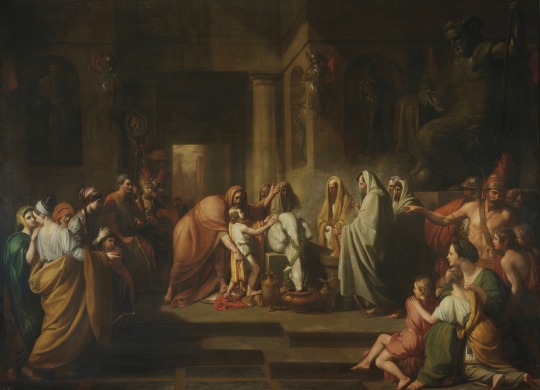
The Carthaginian (present day Tunisia of North Africa) general, Hannibal, was considered one of the greatest commanders of antiquity. Both Greek and Roman historians carefully documented his life. Hannibal allegedly swore at an early age to show animosity towards the Roman Republic due to his father being forced to surrender part of Sicily to the Romans. After this the father and son duo found themselves conquering the Iberian Peninsula. By his early adulthood Hannibal was the commander in chief of the army - with this power he started what is known as the Second Punic War against the Romans. During his many years before beginning this War he assembled mercenaries from Spain, North Africa, and Gaul - his naval fleet became a great armada. His invasion from the Alps took the Romans by surprise and led to an incredible defeat of Roman troops - this is the combat often referred to as the Battle of Cannae. Hannibal fought for many years and up until the very end too - Hannibal became surrounded by Romans and was forced to surrender, but Hannibal poisoned himself instead of submitting to them, his terminal enemies. IN MY OPINION Hannibal in your chart can represent a) where you take charge, b) where you know your enemies best, c) where you are an incredible leader, and/or d) where you remain a mystery and unpredictable to your opponent.
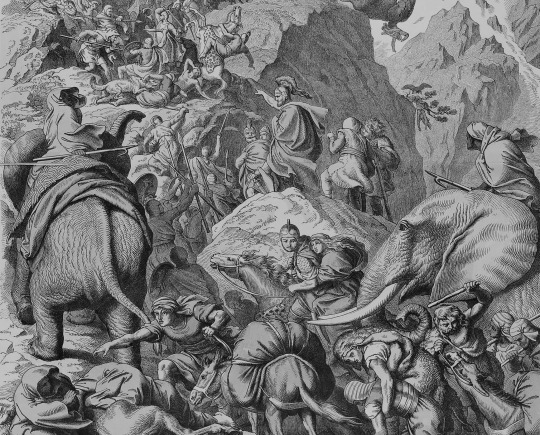
i encourage you to look into the aspects of hannibal along with the sign, degree, and house placement. for the more advanced astrologers, take a look at the persona chart of hannibal AND/OR add the other characters involved to see how they support or impede hannibal!
like what you read? leave a tip and state what post it is for! please use my "suggest a post topic" button if you want to see a specific post or mythical asteroid next!
click here for the masterlist
want a personal reading? click here to check out my reading options and prices!
#astrology#astro community#asteroid astrology#astro chart#astro placements#asteroid#natal chart#persona chart#greek mythology#roman mythology#hannibal#asteroid2152
39 notes
·
View notes
Note
Been on a Romaboo kick for a while. And have been thinking nonstop basically about Roman!Peach, Plum and, Grey.
Peach as a Briton from, maybe a Belgae tribe in what is now Hampshire/Sussex. Captured in battle after the Revolt under Boudicca, before going on to be the Gladiator.
Plum has Pheonecian vibes. Either Carthaginian or from Acre. Definitely came from lots and Lots of wealth. Maybe even a Pre-Punic War Carthaginian family?
Grey is definitely from a Germanic Tribe. Maybe one on the Rhine. Maybe even a Dreaded Goth or Vandal? Coming to Rome as a Mercenary before being hired by Plum?
Sorry if this is too much lol. I am a Massive rome nerd, and your post of Roman Gang brought back my Hyper Focus on the subject lol.
Oh no, I love it when people Nerd out. I have no clue what this means but I love that you got into it!
Honestly adore that AU, lots of unsuaul characteristics to play with there, and long haired grey is peak. plus the outfits.
Alwasy going to encourage folks to go off about hyperfocus topics!
#i wish i was any good at history#but it was and alwasy will be the bane of my school life#failed every class#just so bad at recalling things#but i love that yall out here being nerds#<3#salad#id so draw more of this AU if i had any ideas#hint hint send them#because im a fool#and braindead rn
34 notes
·
View notes
Photo
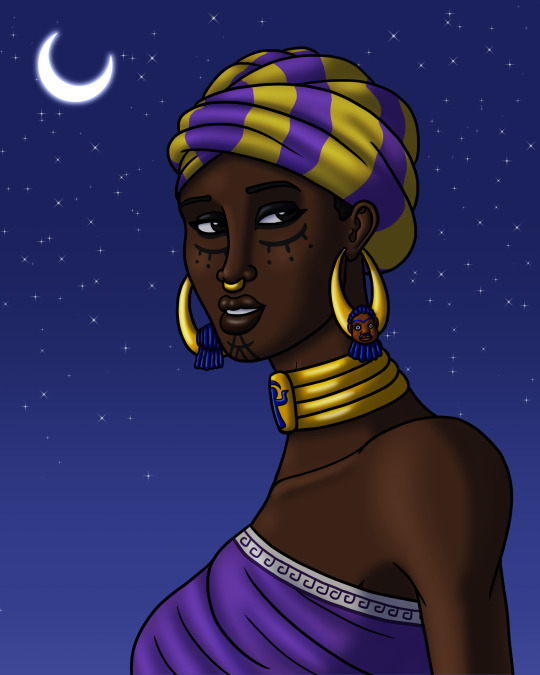
This is my portrait of Salammbo, a priestess of Tanit from ancient Carthage who is the titular character of an 1862 historical-fiction novel by the French author Gustave Flaubert.
Flaubert’s novel takes place during the Mercenary Revolt of 241 BC, with Salammbo having to retrieve a sacred veil after the Libyan mercenary Matho (who lusts after her) steals it. The two eventually come together to make love, but the story ends tragically for both of them, with Salammbo dying of shock upon watching her lover be tortured in anticipation of his execution at the hands of the Carthaginian state.
109 notes
·
View notes
Text
Photos from Ancient Carthage (814BC-146BC)
Ancient Carthage was a city state in the time of antiquity that exists in present day Tunis, Tunisia in North Africa. It was founded around the year 814BC by Phoenician (Punic) settlers who emanated from the Levant, in modern day Lebanon, Syria & Israel. The Phoenicians were a civilization that spoke a Semitic language & engaged in a society that primarily was interested in trade & commerce throughout the Mediterranean Sea.
The Phoenicians settled in trade colonies throughout the Mediterranean basin in not only their West Asian homeland but Europe & North Africa all the way to modern day Spain & Morocco. Their best-known trade colony was Carthage or “Qart-hadast” which meant “New City” in their language. This was strategically located where modern Tunis sits. It was located on a strip of land that allowed shelter from storms on the North African coast & was well placed near the center of the Mediterranean Sea & its trade routes crisscrossing between the east & west. The settlers who established Carthage were Phoenicians colonists from the city of Tyre in modern Lebanon, one of the three major city-states of Phoenicia alongside Sidon & Byblos.
These Phoenician colonists reached Tunisia around 814 BC & like their other settlements in Libya & elsewhere they had to deal with the native populations, in this case the Berber or Amazigh peoples who inhabited North Africa from Morocco to Libya. Originally a daughter city under the rule from Tyre, they gained autonomy when Tyre & the rest of Phoenicia fell under the control of the Neo-Assyrian Empire around 650 BC. From that point on Carthage became not only an independent city-state but established a mostly sea-trade based empire or thalassocracy. It became a flourishing metropolis & dominated the Western Mediterranean for centuries.
Carthage was a monarchy until about 480 BC before becoming a republic & their sea-based commercial empire presaged the later Italian sea-based republics of Venice & Genoa over a thousand years later. Their complex system of governance, language (Punic or Western Phoenician dialect), religion & other cultural aspects are still only partially understood in the modern era due to biased contemporary foreign sources & little surviving local record.
At their peak they controlled North Africa’s coast from Libya in the east to Morocco in the west. Much of Spain, the Balearic Islands, Malta, half of Sicily, all of Sardinia & Corsica. They fought wars with the Berbers who lived inland in North Africa along with the Greek city-states that settled in Sicily & southern Italy & likewise engaged in trade with these peoples. The Phoenician settlers (Carthaginians) were often not numerous enough to make up their whole military strength. Though the Phoenicians dominated their navy while their land-based military consisted of mercenaries from the Berbers of North Africa, Greek hoplites, Sardinians, Italo-Sicilians, Corsicans & the Celts & Iberians of Spain and the Balearic Islands to complement their own elite Phoenician infantry, the Sacred Band of Carthage.
Eventually over the course of the three Punic Wars with the emerging Roman Republic, Carthage lost its power & prestige. Though it produced several military leaders of tactical & strategic renowned, the most famous being Hannibal Barca (247BC-181BC) who crossed the Alps & invaded Italy from the north inflicting several defeats on the Roman army on their native Italian soil but he was never able to take Rome itself. Eventually attrition & the threat of a Roman counterattack against Carthage itself forced Hannibal to leave for his North African home. He was eventually defeated by the Romans & finally in the Third & final Punic War, Rome destroyed ancient Carthage in 146 BC, it is said they tilled the surrounding fields in salt so that no new crops could grow & the threat of Carthage would never rise again. The Romans eventually rebuilt Carthage & included the city as their own within the Africa province of their empire. It flourished again as a center of Roman trade but eventually fell to Germanic invaders such as the Vandals before being retaken by the Byzantine Empire in the 6th Century AD before falling again to the Arab Muslim invaders in the 7th century as Islam spread across North Africa. Medieval Carthage continued as a residential town but eventually the modern city of Tunis began encircling its original Punic & later Roman ruins...

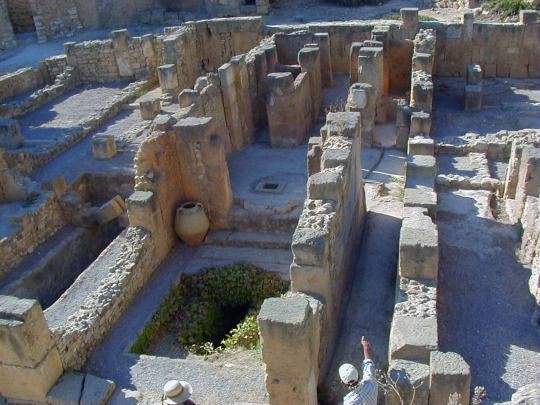
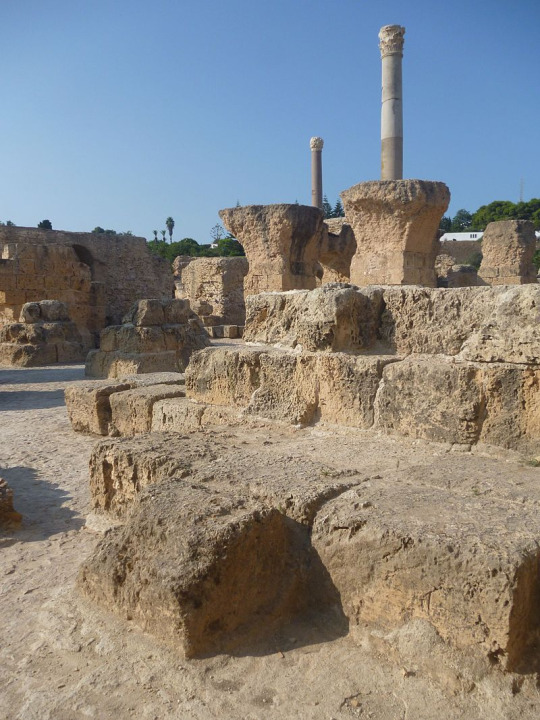
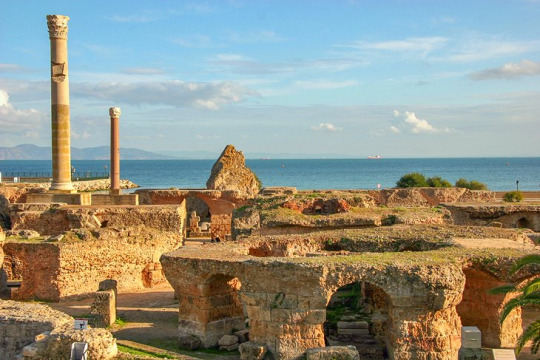

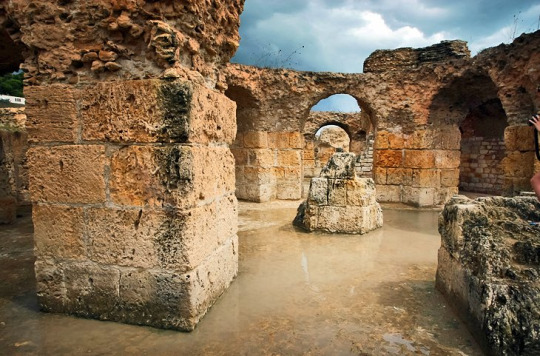


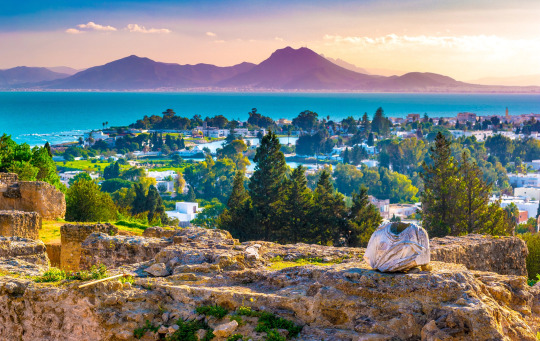
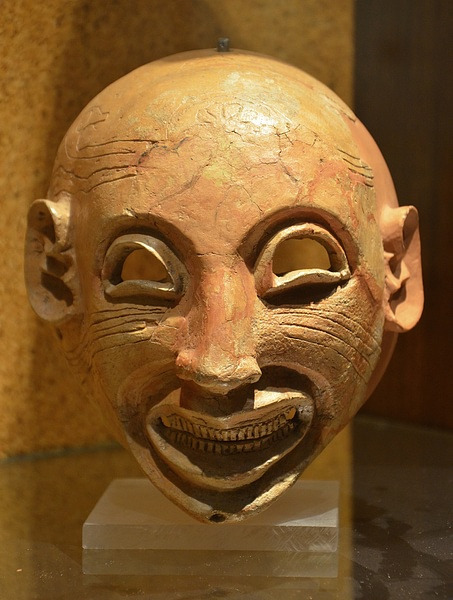
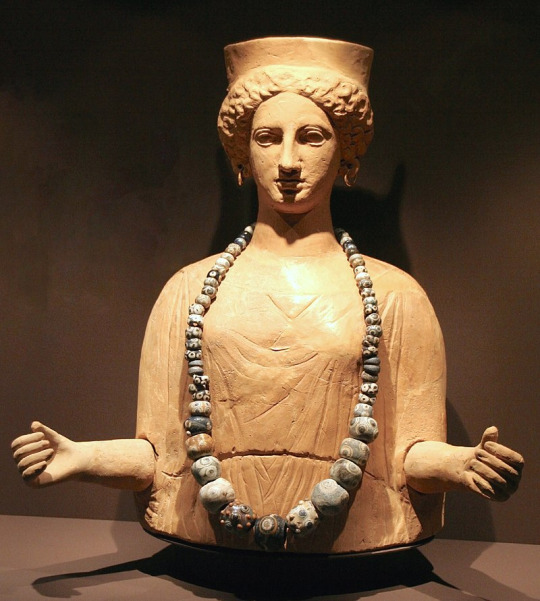

#antiquity#ancient carthage#punic wars#hannibal#ancient rome#tunisia#north africa#ancient world#ancient history#carthage#rome#mediterranean#phoenicia#ancient phoenicia#tyre#baal hamon#tanit#dido#ancient ruins
19 notes
·
View notes
Note
I recently saw a video about the Punic wars and it mentioned Balearic archers! Then I searched more about it and many foreign powers would specifically hire Balearic mercenary to be archers, haha. Is there any reference to this on the Islands?
I assume you mean the Balearic slingers, it's true! They were renowned since Antiquity and part of both the Carthaginian and Roman armies.
For those who don't know what sling means, it's a weapon that consists on a rope that the slinger swings around with a stone projectile, so it can propel and shoot the stone. Like this:

(Image source: Federació Balear de Tir de Fona)
Together with the characteristic shape of their settlements' buildings, the slingers are the most famous element from the ancient Talaiotic culture.
They are known in the Balearic Islands. In the Hort del Rei gardens in the centre of Palma, Mallorca, there is a statue dedicated to a Balearic slinger:
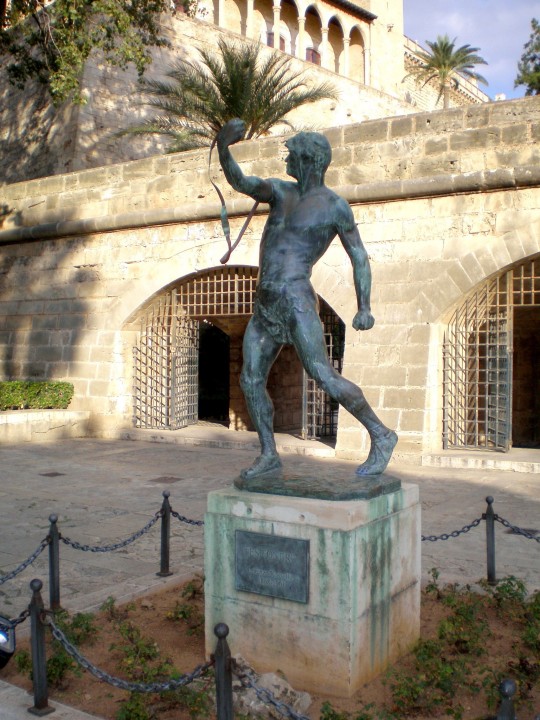
(Image source: Lanoel/Wikimedia)
You can also see slinger's projectiles found by archaeologists:

These ones are from Museu de Menorca (source).
And it never got lost! When newer weapons became more available, the sling continued to be in use by the shepherds of the Balearic Islands to control their herds. Nowadays it's considered a sport and there are sling competitions.
#història#illes balears#ask#anonymous#history#archaeology#ancient#ancient history#antiquity#ancient mediterranean#talaiotic#mallorca#ancient rome#second punic war#punic wars#ancient weapons#weapons
31 notes
·
View notes
Text
"Salammbo" is a historical novel written by Gustave Flaubert and published in 1862. The novel is set in Carthage during the 3rd century BC and is centered around the life of the beautiful and mysterious Salammbo, the daughter of Hamilcar Barca, a powerful Carthaginian general. The story revolves around the conflict between Carthage and Rome, and the events leading up to the First Punic War.
The main plot follows Salammbo's love affair with the mercenary Matho, a member of the Libyan army. Despite her father's opposition, Salammbo and Matho fall deeply in love and their relationship is complicated by the ongoing war between Carthage and Rome. Salammbo must navigate the dangerous political and military landscape of Carthage in order to be with Matho and protect their love.
As the war between Carthage and Rome intensifies, Salammbo becomes increasingly involved in the conflict, eventually playing a crucial role in the outcome of the war. The novel ends with Salammbo making a difficult choice to save her city and her love, sacrificing herself for the greater good.
"Salammbo" is a complex and historical novel that explores themes of love, war, religion, and politics. It is widely regarded as one of Flaubert's most important works and is considered a classic of French literature.
2 notes
·
View notes
Video
youtube
Publius Cornelius Scipio "Africanus": A General Greater Than Napoleon
Literally the creator of Roman strategy.
The first Punic War was the first time Rome left Italy. Rome has great heavy infantry, but had no idea how to navy. They built a navy within a couple years of first trying and beat the Carthaginians back to Africa.
Carthage were merchants, and had no idea how to fight, often picking locations that were better for the Romans. Cathage hired a single Spartan, whom changed the entire course of the war.
*end first punic war*
The Second Punic War starts with Hannibal, whom took the lessons in Strategy, and devastated a much larger Roman army at Cannae, in Italy. The Romans at the time found strategy to be dishonourable. It wasn’t until Africanus came along that they started to actually use strategy.
Carthage was also a trading city. It uses hired mercenaries to do most of it’s fighting. Rome’s legions fought for Rome, while mercenaries were open to negotiation. The end result is that Africanus added Hispania, the first Roman provinces from outside Italy.
Runtime: 30:52
4 notes
·
View notes
Photo

Romans versus “Barbarians”: A Military Comparison, Part Two
An Original Essay of Lucas Del Rio
Note: This is the second installment of an essay that will be four parts in total. The previous installment has already been posted on my blog. Each section chronologically covers the wars fought by the Romans in the events leading up to the dawn of the Middle Ages. A special focus is on how both the Romans and their adversaries, whom the former referred to the latter as “barbarians,” fought in terms of tactics and weaponry. In this segment of the essay, the focus will be on the Roman wars with the Carthaginians, Iberians, Macedonians, and Seleucids.
The Roman Republic was in a strong position once it had secured control over all of Italy. However, it was not yet at this point the dominant power in the Mediterranean, or even in the western Mediterranean. For several centuries prior to the Roman unification of Italy, the title of being the greatest Mediterranean realm had belonged to Carthage. Located in modern Tunisia, the city of Carthage was initially founded by Phoenicians. A culture that emerged in the Bronze Age, the Phoenicians were Canaanites in the Levant who spoke a Semitic language. Their early history is poorly documented, but at their peak, they were expert sailors and traders. Some Phoenicians traveled as far as the Atlantic. Folklore states that a Phoenician queen, whose name has been disputed, founded Carthage in 814 BC. If this is true, the city was founded sixty-one years before the Romans claimed that their own city was established. Some historians believe that the conquest of the Levant in 538 BC by Persian King Cyrus the Great caused many Phoenicians to settle elsewhere, including in Carthage.
Cyrus the Great was not the only conqueror whose actions led to an increase in the strength of Carthage while their ancestral homeland of Phoenicia declined. Later, in 332 BC, Alexander the Great seized the region from the Persians. Alexander ravaged Phoenicia, and those that were able to flee did so. In the years that followed, Carthage established vast trade routes, allowing it to grow and prosper as it sold dye, glass, and ivory throughout the Mediterranean. The Carthaginians had formed an empire by the 600s BC with colonies across North Africa. These endeavors led them to build a feared and formidable navy. They also developed a military, learning to vigorously utilize javelin throwing cavalry from their allies, the neighboring Numidians. Like many empires at the time, the Carthaginians employed chariots early on and would increasingly copy Greek and Macedonian phalanxes. During this point in history, there were still elephants in North Africa, and they trained these elephants for battle. Carthaginian war elephants were armored, had their tusks outfitted with sharp objects, and usually carried two soldiers.
The Carthaginian army included native Carthaginians, who occupied all leadership roles. However, the bulk of its forces were foreign mercenaries. These included Balearic slingers, both Celtic and Iberian swordsmen, Cretan archers, and Libyan warriors who fought with axes. Eventually, these soldiers would end up fighting the Romans, although the two cultures had not always been enemies. In fact, prior to the Punic Wars, their societies had been close trade partners who were generally on positive terms. At the time that the Romans had largely secured control of mainland Italy, the nearby island of Sicily was almost entirely Carthaginian territory. This may have allowed both empires to do business with one another, but the close proximity of the island and the peninsula began to spark tensions. Pyrrhus had remarked after his defeat in Italy by the Romans that war between Carthage and Rome war was inevitable.
The Punic Wars would not be the first time that Carthage had experienced a major military confrontation. Prior to the Punic Wars, the Carthaginians had to fight a Greek general named Agathocles. A former mercenary, it was actually with their help that Agathocles was able to establish his own military dictatorship. In 317 BC, he seized power in Syracuse, a colony of the Greek city-state of Corinth and the only major city on the island of Sicily other than Acragas not controlled by the Carthaginian Empire. Still not content, Agathocles invaded other cities on the island. While the Carthaginians managed to repel these attacks, Agathocles was able to escape with sixty ships before Syracuse could be captured. By doing so, he managed to bring fourteen thousand soldiers to Africa. At this time, Carthage was battling an uprising, plus its soldiers in Sicily were struggling to take Syracuse despite the absence of its leader. Agathocles was making impressive progress in conquering cities belonging to Carthage, but he went back to defend Syracuse once he realized his city was beginning to fall. He was forced to sign a peace treaty with the Carthaginians in 306 BC and agreed to give them their cities back, although he continued to conduct military campaigns elsewhere for the duration of his life.
Like the war that the Carthaginians were forced to fight against Agathocles, the starting battleground of the First Punic War would be in Sicily. It began as a proxy war, as the Romans became involved in a power struggle on the island concerning Carthage. Mercenaries known as the Mamertines previously had employment with the monarchy in Syracuse. After their work for the city had concluded, they chose to seize control of a different city known as Messina. In an attempt to avoid facing the wrath of Carthage, the Mamertines went to the Roman Senate to seek an alliance. Even though Carthage and Rome had not previously been adversaries, the Romans now saw an opportunity to expand into Sicily and in 264 BC sent soldiers. Before long, the two empires had entered a state of open warfare. Both sides knew the strengths of their opponent and thus tried to keep the combat that they excelled at. Carthage had the advantage of a highly formidable navy, whereas serious naval warfare was something that the Romans had never previously experienced. On the other hand, the Carthaginians, with their dependence on foreign mercenaries, lacked a land formation of their own that could compete with Roman warriors, who fought in legions.
The Carthaginian advantage at sea would not last long against the industrious Romans. Ships captured by the Romans were examined by Roman engineers, who learned how they could build their own. Unlike the Carthaginians, who sunk enemy ships with rams attached to their own, the Romans employed the tactic of boarding the Carthaginian ships with legionnaires. As the war went on, the Romans won battle after battle despite the brave efforts of Hamilcar Barca, a commander who is still celebrated in the field of military history. Because the situation in Sicily remained a stalemate, the Roman army invaded Africa directly in 256 BC. Carthage sought the help of a Spartan military commander by the name of Xanthippus, who helped repel the Roman onslaught, yet it was still not enough for Carthage to win the war. In 241 BC, the Carthaginians surrendered and were forced to give up Sicily, plus give the Romans tribute. However, despite this surrender, the Carthaginian Empire retained its sovereignty, as it had not yet been defeated.
Much of what happened in the years following the First Punic War were not kind to Carthage. As Sicily had been one of its most important trade destinations, funds were lacking to pay the mercenaries that composed much of the Carthaginian army. Between 240 and 237 BC, a conflict occurred known as “the Mercenary War” in which many of their mercenaries revolted. While Carthage managed to defeat the rebels, the Romans took advantage of the situation to seize Corsica and Sardinia, two other major islands in the Mediterranean. The sea had become dominated by the Romans, who were now an unmatched naval power. However, the Carthaginians were still trying to reestablish themselves as a major power. They decided to colonize the Iberian Peninsula, where they founded various settlements, including the city of Cartagena in 228 BC that still stands today. Hamilcar Barca, the aforementioned general, played an active role in Carthaginian military operations in Iberia. His son, Hannibal, and his son-in-law, Hasdrubal, followed in his footsteps.
Peace between the two cultures would not last. Hamilcar died in 228 BC, but both Hannibal and Hasdrubal would continue fighting for the empire they served. Silver mines captured in Iberia eased the strain on the Carthaginian economy that had been caused by the tribute owed to the Romans. The silver also allowed for the military to expand again. With Carthage resurgent, the empire would soon strike back. Rome, having recently defeated Celtic allies of Carthage to the north of Italy, were not worried about the possibility of another war. Hannibal led an army to seize a town in Iberia called Saguntum in 219 BC, which startled the Romans, as the Saguntines were their ally. However, while the move provoked Rome, nothing about this particular action by the Carthaginians was in violation of any diplomatic treaty between the two societies. If anything, the Romans had acted illegally by allying with these people, as the town was in a location that both sides agreed was to be reserved for the Carthaginians. Rome demanded that Carthage extradite Hannibal, which they did not. It was the start of the Second Punic War in 218 BC, in which the Romans would see plenty more of Hannibal.
Hannibal first gathered an army in Iberia, which included many Iberian mercenaries. Prior to his death, Hamilcar had been trying to build a more effective army for Carthage after the defeat in the First Punic War had largely been the result of a weak one. Due to the strong presence that the Carthaginians now had on the Iberian Peninsula, recruiting the locals for the new war would have been a logical choice. Most obviously, the region was fairly close to Italy, which Hannibal intended to invade. Additionally, the Iberians were fierce warriors who had mastered fighting as both infantry and cavalry. Like their Roman counterparts, Iberian infantry carried large shields, were heavily armored, and threw javelins at their enemies before charging. By the time of the Second Punic War, it had become clear that Roman legionnaires were some of the best melee infantry in the known world. However, the Iberians had some advantages in melee combat. Legionnaires were still generally armed with spears, and those that fought with swords still carried a now outdated variety long used in Greece. Years later, legionnaires started to be equipped with a type of sword that they called the “gladius hispanicus,” a weapon, based on the Iberian “falcata,” that would also famously become common in brawls between gladiators.
As previously stated, the Iberians were also very skilled at fighting on horseback. Like the Spanish cavalry that would later exist in the region many centuries later, the Iberians had a combination of both heavy and light cavalry. Whereas the heavy cavalry wielded both lances and their signature swords, the light cavalry threw javelins. Hannibal, of course, had a variety of soldiers in the army that he amassed to invade Italy, with ninety thousand infantry and twelve thousand cavalry. He also mustered forty war elephants. Carthaginian war elephants had previously been of the variety indigenous to North Africa, but it has been theorized that Hannibal acquired Asian elephants for his campaign against Rome. If this is true, the elephants were likely supplied by the Ptolemies, the dynasty that then ruled Egypt. The Ptolemies were on friendly terms with Carthage and had trade routes with the east.
The Second Punic War was arguably the greatest threat to Rome for centuries to come. Hannibal knew that he could not give Rome the chance to invade Africa, as it had done to win in the First Punic War. He therefore decided that his first move would be to march his troops directly from Iberia to Italy. In doing so, the army commanded by Hannibal had to cross over the Alps, which resulted in twenty thousand soldiers dying. It was probably especially disappointing to Hannibal that only one elephant survived the journey. However, this did not stop him. Rome expected his weakened army to be defeated quickly, but Hannibal proved to be a tactical genius and won countless battles. His army wandered and ravaged Italy until 203 BC. Like Pyrrhus years earlier, the main reason for his defeat was his inability to replenish fallen troops after major battles. Carthage did little to provide support to Hannibal, and he failed to find many allies among conquered Italians that he expected would want an opportunity to revolt.
Rome would defeat Carthage in a similar manner that they won the first time. After Hasdrubal failed in an attempt to reinforce Hannibal, the Romans invaded Iberia and then Africa, conquering all of the Carthaginian Empire except for its capital city. Hannibal had arrived with his army, but it was too late. In 202 BC, Carthage was forced to agree to another humiliating peace treaty. From 149 to 146 BC, there would be a Third Punic War, which occurred when Rome was making various rather absurd demands. Perhaps the most bizarre of these was that the Romans wanted the Carthaginians to abandon their city and found a new one further away from the sea. Carthage had also declared war on the Numidians, which the Carthaginians were forbidden to do according to the prior peace treaty. This time, Carthage was very weak, and the Romans chose to raze the city once and for all.
During the lengthy span of time that the Roman Republic waged war against Carthage and its colonies, the world of classical antiquity saw other violent conflicts elsewhere. Several dynasties with roots in wars that had occurred decades before the Romans united Italy would be among the next barriers to Roman expansion. The story of these dynasties begins with Alexander the Great, the Macedonian conqueror who defeated the entirety of the Persian Empires. His death in 323 BC without an heir left the mighty realm that he had built without anyone to succeed him. Decades of violence they called “the Wars of the Diadochi” followed, with several former generals of Alexander carving out pieces of his domain. Even his homeland of Macedon was not spared. Macedon and its new line of rulers became known as “the Antigonid Dynasty,” even though Antigonus was killed in one of the wars. Philip V, who was one such ruler, went to war with the Romans in 215 BC in hopes that he could help Carthage contain the rising power of Rome.
Ten years after the start of the first of the Macedonian Wars, Rome made peace with Macedon. Unlike the Carthaginians, who had lost territory fighting the Romans, Philip V was able to gain some. However, further warfare between Macedon and Rome would favor the latter. The Macedonians began to militarily annex various Greek city-states in violation of the peace treaty, prompting a declaration of war by Rome in 200 BC. Rome brought elephants, which along with Roman legions, the Macedonian phalanxes were helpless against. By 196 BC, Rome had won, and the Romans assumed control of most of Greece. An additional two wars also ended in Macedonian defeats, with the ultimate result being full Roman control of the region. Another, more powerful successor state to the realm of Alexander the Great, known as “the Seleucid Dynasty,” also fell victim to Rome and its legions.
#ancient#ancient rome#ancient warfare#antiquity#civilization#classical antiquity#classical era#classical warfare#essay#history#legion#military history#punic wars#roman republic#rome#society#tactics#war#warfare#warriors
4 notes
·
View notes
Text
Conceptualizing Medieval African Civilizations
In popular culture there has been a great amount of love for East Asian and Western European cultures, but this sometimes acts as a determent that overshadows other civilizations. Areas such as Africa have often been overlooked in its history and culture. This is in part due to European imperialism which generated a number negative stereotypes, many of which reverberate through popular media into the modern day. Even if one were to put aside the imperialist perception of Africa, there still remains a great lack of knowledge for what cultures it bore.
Like many other civilizations that exist across the globe, geography plays an integral part in understanding what shaped the various polities across Africa.
North Africa:
North Africa, known as the Maghreb (Arabic for West), consists of a fertile coastline dotted with mountains that borders the Mediterranean Sea. Its indigenous inhabitants, called the Amazigh, often led nomadic lives but also established sedentary communities and built cities. One well-developed Amazigh polity was the kingdom of Numidia, known for its trade with the Egyptians and their use of Numidian cavalrymen as mercenaries. The Mauritanians were another Amazigh kingdom known for their production of goods. These kingdoms originally emerged from nomadic tribal confederations that eventually developed into lineages of kings based on patrilineal descent.
Surprisingly, there existed an Amazigh kingdom that thrived within the Sahara desert. This polity sustained itself through a complex system of irrigation canals that drew water from deep underground. Access to water allowed for city-building, farming, and possibly even trade with Sub-Saharan Africa. Among the first foreign populations to settle among the Amazigh were the Phoenicians, originally from the Levant. These naval merchants traveled across the Mediterranean Sea, trading as far as Spain. A subgroup of the Phoenicians settled in the city of Carthage, eventually expanding into a thalassocratic trade empire. The Carthaginians formed alliances, traded, and clashed with the local Amazigh tribes.
Over time, the Romans emerged from Italy and subjugated both the Carthaginians and the Amazigh peoples, incorporating them into their empire. During the era of the Roman Empire, the North African provinces, along with Egypt, served as a breadbasket for the entire empire. Due to its geographical isolation, with the Mediterranean Sea and the desert acting as natural barriers, the Maghreb became not only a breadbasket but also one of the most peaceful provinces of the Roman Empire.
However, this long period of peace came to an end when the Vandals, a Germanic tribe, migrated across Europe and seized control of North Africa, establishing their own kingdom. The Vandal kingdom was short-lived and eventually reconquered by the Eastern Roman Empire. Roman rule in North Africa would later come to an end with the Arab conquests. This period in history spread the Arabic language and incorporated North Africa into the cultural sphere of the Islamic Caliphate. Many Amazigh soldiers were utilized in the Muslim conquest of Spain. Under the Umayyad dynasty, the Caliphate expanded from the Atlantic Ocean to the Indus River. Unfortunately, the Arabic hegemony of the Umayyad Caliphate inflamed ethnic tensions, leading to rebellions by native Amazigh tribes who formed their own independent kingdoms. The Umayyad dynasty was later overthrown, and with the help of the Persians, a new Arab dynasty known as the Abbasids took over. Although the Abbasids claimed authority over the Maghreb, they ruled in name only. As the Middle Ages progressed, it became clear that the Amazigh kingdoms had become autonomous polities.
Egypt and Nubia:
For many centuries the sahara desert acted as a massive barrier between North Africa and its more forested regions to the south. Only nomadic amazigh tribes are known to have thrived in this environment, many of which still maintain their ancient traditions to this very date. While it is only speculated that the Amazigh kingdom of the Garamantes may have faciliatted trade with subsarahrn africa, it is quite clear that the nile river had indeed done so. While Egypt is a very well known civilization, many neglect the true origin of the Nile river. Within the regions of subsaharan africa, lake victoria and lake tana flow north words as the blue and white nile, merge into a single river. The Kushites, a broad name for those who lived south of Egypt, often contended against Egypt for domination of the Nile River. Though they warred against one another, the Kushites maintained a great deal of material trade and culteral exchange.
Blaze
0 notes
0 notes
Text
The glory of Rome awaits you in this addictive Tower Defense and war strategy game.
Play Grow Empire: Rome and turn your small town into the largest and most powerful empire in history.
Strategically upgrade your walls, towers and warriors, and protect your city from attacking elephants, siege weapons and waves of enemy troops by covering the sky with arrows and fire.
Confront fearsome armies of barbarian, Gallic, Iberian and Carthaginian warriors and expand your empire throughout Europe and Africa.
Defend your colonies and fill your coffers with gold with their tributes. Become the leader that Rome claims.
Conquer enemy cities and obtain chests with gems, gold, potions and cards!
Create an invincible army of heroes, legionaries, mercenaries and siege weapons that will make you the most feared Caesar in history.
⚔ Features: ⚔
★ +1500 waves that will test your defense / courage.
★ +120 cities to conquer.
★ Test your archer skills with Tavern mission mode.
★ +1000 building upgrades.
★ +35 different Roman troops to boost your army.
★ 4 enemy factions that will test your thirst for glory.
★ Siege weapons and war elephants!
★ 7 heroes with unique abilities that will help you conquer all.
★ +18 Abilities of 20 different levels to improve your attack and defense strategy.
★ 18 offensive and defensive cards to boost your game strategy.
What are you waiting for? Download the game and let the conquest begin!
⚔ Live the full Grow Empire: Rome experience, Follow us on our social networks.
Instagram @growempirerome/
Facebook @growempirerome/
YouTube https://www.youtube.com/c/GrowEmpireRome
Discord: https://discord.io/growempirerome
⚔ Hey conqueror, if you are a video creator or streamer, we would love to see your content on YouTube. We support and promote channel creators, so if you want us to showcase your videos or want to know more about our game, feel free to email us at [email protected]
👉 Got a problem? Contact us at [email protected]
👉 Terms of use and privacy: https://gstationstudio.com/privacypolicy/
0 notes
Text
Men as far away as modern day Ukraine were hired as mercenaries and fought for a Greek city in *Sicily.* Against the Carthaginians, who also used mercenaries, mostly from places like modern day Libya and surrounding areas (Iberian mercs came later).
So in 409 BCE, warriors from Eastern Europe fought against warriors from North Africa in a battle for a Greek colony on the Mediterranean island of Sicily. The ancient world was much more connected than we tend to imagine, and not just by trade.
#himera#archaeology#ancient war#carthage#ancient greek#ancient sicily#battle of himera#ancient mercenaries
1 note
·
View note
Text
The Origins of - Free-lance: An unattached journalist who sends out his literary wares on approval. The term . . . #english #ingles
The Origins of – Free-lance: An unattached journalist who sends out his literary wares on approval. The term . . . #english #ingles
An unattached journalist who sends out his literary wares on approval. The term has been derived from those roving companies of knights who, at the close of the Wars of the Crusades, were ready to enlist under any banner for a monetary consideration. Like the mercenaries of the Carthaginians and Romans, these were the first paid soldiers.
Source: Phrases and Names Their Origins and Meanings by…

View On WordPress
0 notes
Text
During the first Punic war, Carthage lost every single land battle to Rome. When the Romans landed their legions near the capital and began marching towards the great city of Carthage, the situation became really hopeless.
All this time, the Carthaginians were recruiting fighting men from all over the Mediterranean region to fight for their cause.
And around the time the Romans landed in Africa, a large group of recruits from Greece arrived in Carthage. Among these soldiers was a badass Spartan mercenary commander.
His name was Xanthippos.
When Xanthippos arrived in the city and saw the Carthaginian army, he was astonished. The army wasn’t as bad as everyone believed! It had some decent infantry units, numerous cavalry and mighty war elephants. In reality, the problem was Cartage’s generals who didn’t know how to use the army properly.
Because the Romans were nearing the city, in a desperate attempt to save themselves, the Carthaginians thought about granting supreme command of their army to Xanthippos.
To give full control of their army to a stranger was something unheard of and many nobles protested against this move.
Yet, what else could they do with the enemy approaching at the gates?
It was a situation of life and death.
Hence, in the end, they decided to make the Spartan captain grand general. Xanthippos took command of the army and began to drill it. When the time came, he left Carthage in the spring of 255 BC and faced the legions at the Battle of Tunis. In this battle, he surrounded the Romans with his superior cavalry and annihilated them. Of the original 15.500 Roman force, only 2.000 men managed to escape death and captivity.
So…
What can you learn from this story?
Sometimes the problem isn’t what you think.
I have seen many good men that could attract girls but don’t know how to do it.
Sometimes, if your dating life I a mess, and you don’t know why you can’t find the love you deserve, it is better to ask for help and not try to figure out everything by yourself.
I know that it is an ego thing for men.
I was exactly like that once.
I couldn’t drop my ego and ask for help.
I was too proud to admit that I sucked with ladies.
Yet, when I did it, and found men that could help me it changed everything. Often the best thing you can do is what is most uncomfortable.
Therefore, if you have trouble attracting, dating, and seducing the women you desire, just find somebody that is good with ladies and ask for help. This is the most practical and clever thing to do.
That is for today…
If you want to read more stories on flirting, dating, and seduction, just click the link below and subscribe to my mailing list:
www.OrdinaryTitan.com
Your Greek buddy Phoenix.
0 notes